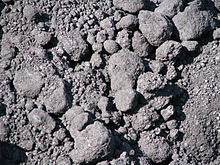- Petroleum coke
-
Petroleum coke (often abbreviated Pet coke or petcoke) is a carbonaceous solid derived from oil refinery coker units or other cracking processes.[1] Other coke has traditionally been derived from coal.
Marketable coke is coke that is relatively pure carbon and can be sold for use as fuel (i.e. fuel grade coke), or for the manufacture of dry cells, electrodes, etc. (i.e., anode grade coke). Needle coke, also called acicular coke, is a highly crystalline petroleum coke used in the production of electrodes for the steel and aluminium industries and is particularly valuable because the electrodes must be replaced regularly. Needle coke is produced exclusively from either FCC decant oil or coal tar pitch. Catalyst coke is coke that has deposited on the catalysts used in oil refining, such as those in a fluid catalytic cracker. This coke is impure and is only used for fuel.
Fuel Grade Coke is classified as either sponge coke or shot coke morphology. While oil refiners have been producing coke for well over 100 years, the mechanisms that cause sponge coke or shot coke to form are not well understood and cannot be accurately predicted. In general, lower temperatures and higher pressures promote sponge coke formation. Additionally, the amount of heptane insolubles present, and fraction of light components in the coker feed contribute.
Its high heat and low ash content make it a good fuel for power generation in coal fired boilers, but petroleum coke is high in sulfur and low in volatile content which pose some environmental and technical problems with its combustion. In order to meet current North American emissions standards some form of sulfur capture is required, a common choice of sulfur recovering unit for burning petroleum coke is the SNOX Flue gas desulphurisation technology[2][3], which is based on the well-known WSA Process. Fluidized bed combustion is commonly used to burn petroleum coke. Gasification is increasingly used with this feedstock (often using gasifiers placed in the refineries themselves).
Calcined petroleum coke (CPC) is the product from calcining petroleum coke. This coke is the product of the coker unit in a crude oil refinery. The calcined petroleum coke is used to make anodes for the aluminium, steel and titanium smelting industry. The green coke must have sufficiently low metals content in order to be used as anode material. Green coke with this low metals content is referred to as anode grade coke. The green coke with too high metals content will not be calcined and is used for burning. This green coke is called fuel grade coke.
Traditionally in India the prices of petroleum coke have remained higher than Fuel oil. However due to excess production in the recent past the values have dropped and are currently in the range of Rs. 17,000 / M.T.
See also
- Delayed coker
- Tar
- List of CO2 emitted per million Btu of energy from various fuels
References
- ^ IUPAC, Compendium of Chemical Terminology, 2nd ed. (the "Gold Book") (1997). Online corrected version: (2006–) "petroleum coke".
- ^ The SNOX process is described
- ^ Schoolbook, Chemistry 2000, Helge Mygind, ISBN 8755909922
External links
- IUPAC definition of various forms of solid carbon.
- BP info on how calcined petroleum coke is produced
Categories:- Chemical processes
- Oil refining
- Solid fuels
Wikimedia Foundation. 2010.

